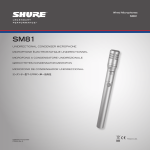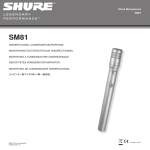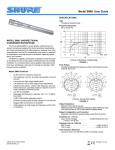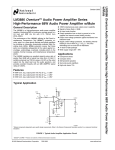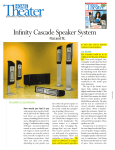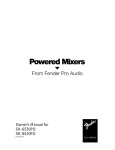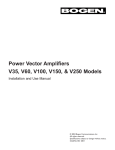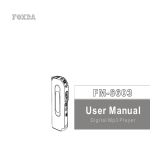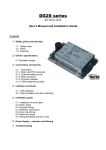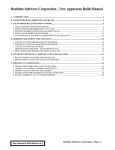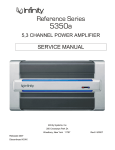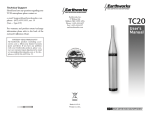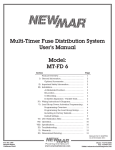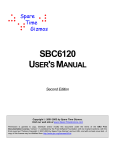Download Model SM81 User Guide
Transcript
Shure Brothers Incorporated 222 Hartrey Avenue Evanston IL 60202-3696 U.S.A. Model SM81 User Guide SPECIFICATIONS Type Cardioid Frequency Response 20 to 20,000 Hz (see Figure 1) MODEL SM81 UNIDIRECTIONAL CONDENSER MICROPHONE The Shure Model SM81 is a high-quality, unidirectional condenser microphone designed for the most demanding professional applications in studio recording, broadcasting, and sound reinforcement. It is especially suitable for applications requiring extremely wide frequency response, low noise and distortion characteristics, very low RF susceptibility, and reliable operation over a wide range of temperature and humidity extremes. The case is constructed of steel for ruggedness, with a stainless steel screen, and finished in durable vinyl paint. The microphone is furnished with a swivel adapter, attenuator lock, windscreen, and carrying/storage case. It is supplied without cable. Available accessories are a highly efficient pop-filter grille (Model A81G), a heavy-duty windscreen (Model A81WS), a compact, lightweight microphone stand (Model S15) capable of extension to 4.3 m (14 ft), a versatile stereo microphone adapter (Model A27M), and a dual-channel phantom power supply (Model PS1A). An alternative omnidirectional cartridge (Model R104A) is also available. TYPICAL FREQUENCY RESPONSE FIGURE 1 Polar Pattern Cardioid (unidirectional) response—uniform with frequency, symmetrical about axis (see Figure 2) Model SM81 Features: • Wide-range, frequency response for exceptionally accurate recording and sound reinforcement applications • Low noise and high output clipping level characteristics • Low distortion characteristics over the entire audio spectrum for a wide range of load impedances • Cardioid polar pattern, uniform with frequency and symmetrical about axis, to provide maximum rejection and minimum coloration of off-axis sounds TYPICAL POLAR PATTERNS FIGURE 2 Output Impedance Rated at 150 ohms (85 Ω actual) Recommended minimum load impedance: 800 Ω (May be used with loads as low as 150 Ω with reduced clipping level) • Very low RF susceptibility • Selectable low-frequency response: flat, 6 or 18 dB/octave rolloff • 10 dB attenuator accessible without disassembly; lockable in either position • Wide-range phantom powering includes DIN 45 596 voltages of 12 and 48 Vdc Open Circuit Voltage . . . . . . . . . . . . . . . . . –65 dB (0.56 mV) (0 dB = 1 volt per µbar) Equivalent Power Level . . . . . . . . . . . . . . . . . . . . . . –40.5 dB (0 dB = 1 milliwatt per 10 µbars) • Rugged construction for outstanding reliability Clipping Level (at 1,000 Hz) • Field-usable over wide range of temperature and humidity conditions 800 Ω Load . . . . . . . . . . . . . . . . . . . . . . . . . . –4 dBV (0.63 V) 150 Ω Load . . . . . . . . . . . . . . . . . . . . . . . . –15 dBV (0.18 V) 1996, Shure Brothers Inc. 27A2916 (PA) Output Level (at 1,000 Hz) Printed in U.S.A. Total Harmonic Distortion Weight Less than 0.5% (131 dB SPL at 250 Hz into 800 Ω load) Net . . . . . . . . . . . . . . . . . . . . . . . . . . . . . . . . 230 grams (8 oz) Packaged . . . . . . . . . . . . . . . . . . . . . . . . . . 1.2 kg (2 lb 10 oz) Maximum SPL (at 1,000 Hz) 136 dB (attenuator at 0); 146 dB (attenuator at 10) with 800 Ω load 128 dB (attenuator at 0); 138 dB (attenuator at 10) with 150 Ω load *S/N ratio is difference between microphone output at 94 dB SPL and microphone self-noise A-weighted. **Designed to mate with Cannon XL series, Switchcraft A3 (Q.G.) series or equivalent connectors. Hum Pickup Certification –3 dB equivalent SPL in a 1 moe field (60 Hz) Output Noise (equivalent sound pressure levels; measured with true rms voltmeter) 16 dB typical, A-weighted 19 dB typical, weighted per DIN 45 405 Conforms to European Union directives, eligible to bear CE marking; meets European Union EMC Immunity Requirements (EN 50 082–1, 1992); RF radiated (IEC 801–3); ESD (IEC 801–2); EFT (IEC 801–4). Signal-to-Noise Ratio The SM81 is designed for phantom powering by Shure Model PS1A Power Supply, or by virtually any microphone power supply providing 12 to 48 Vdc phantom voltage. Use only high-quality cables, as intermittent shorts between broken shield wires and balanced conductors will cause extremely large noise transients in the system. Avoid ground loops due to grounded connector shells or the microphone case touching other grounded metal objects. Follow generally accepted audio grounding practices. Paralleling or “Y-ing” the SM81 with another microphone (two microphones on the same input) is not recommended; separate inputs are preferable. However, paralleling two SM81’s may be accomplished with either a reduction in maximum SPL and output level, or a reduction only in output level if the microphones are electrically isolated. With the microphones paralleled either before or after a PS1A Power Supply, the maximum SPL is reduced by approximately 10 dB and the output level by 6 dB. The reduction in maximum SPL can be avoided by using either two Shure A15AS Attenuators and a Switchcraft 391Q43 Y-Adapter to isolate the microphones, or an isolation network as shown in Figure 4. The network reduces each microphone output level by 8 dB, while the A15AS reduces the output level by 5 dB plus the attenuator’s 15, 20, or 25 dB (switch-selectable). The network or attenuators can be inserted between the power supply outputs and mixer input, or between two microphones and a single power supply input. Note that a PS1A Power Supply can power two SM81’s on each input; other power supplies should be checked to see if they can supply a minimum of 10 Vdc at each microphone when both microphones are connected. A minimum load impedance of 800 Ω or greater should be used for maximum signal handling and minimum distortion. The load may be as low as 150 Ω, but a reduction in output clipping level will result. It should be noted that the power supply itself may add loading (3300 Ω in the Shure PS1A power supply) to the microphones. OPERATION 78 dB (IEC 651)* at 94 dB SPL Overvoltage and Reverse Polarity Protection Max. External Voltage Applied to Pins 2 and 3 with Respect to Pin 1 . . . . . . . . + 52 Vdc Reverse Polarity Protection . . . . . . . . . . . . . . 200 mA max. (diode-clamped) Phasing Positive pressure on diaphragm produces positive voltage on pin 2 relative to pin 3 Cartridge Capacitance 54 pF LP Response Switch Flat, –6 dB/octave below 100 Hz, –18 dB/octave below 80 Hz Attenuator Switch 0 or 10 dB (120 pF) Power Supply Voltage . . . . . . . 11 to 52 Vdc, positive pins 2 and 3 Current Drain . . . . . . . . . . . . . . . . . . . . . . . 1.0 mA to 1.2 mA Environmental Conditions Relative Humidity 0–50% . . . . . . . . . . . . . . . . – 29 to 74 C (–20 to 165 F) Relative Humidity 0–95% . . . . . . . . . . . . . . . – 29 to 57 C (–20 to 135 F) Connector Professional 3-pin audio** Case Steel construction with metallic vinyl paint finish and stainless steel screen Dimensions See Figure 3 OVERALL DIMENSIONS FIGURE 3 2 FROM MIC 1 2 OUTPUT 3 1 2 3 1 FROM MIC 2 2 3 1 ALL RESISTORS 232 Ω, 1% ISOLATION NETWORK FIGURE 4 PS1A POWER SUPPLY Connect the microphone cable to the SM81 and the power supply MICROPHONE connector. The power supply uses the balanced audio cable pair to carry the supply current to the microphone, and the cable shield as a ground return. Connect the power supply OUTPUT connector to a lowimpedance microphone input of the mixer, audio console or tape recorder. A second SM81 may be connected to the remaining power supply channel in a similar manner. RESISTOR R VALUES FIGURE 7 critical. Note that the two-resistor phantom power supply (Figure 5) presents a load equal to 4R, paralelled with the mixer input impedance, to the SM81. If the combined parallel load is below 800 Ω, the transformer configuration (Figure 6) is recommended, and if the combined load is 150 Ω or less, it must be used. ALTERNATE POWER SOURCES As an alternate to the PS1A power supply, the SM81 may be phantom powered from virtually any mixer, audio console or tape recorder using one of the wiring configurations shown in Figures 5 and 6. Any well-filtered voltage available in the mixer from 12 to 48 Vdc may be used. The graph in Figure 7 shows the range of values which can be used for resistor R when the SM81 is used with a regulated power supply. The tolerance of the resistors (2R) shown in Figure 5 should be 1% or better to assure close matching, although the absolute value is not If the power supply is unregulated, the power supply voltage may drop when the SM81 is connected to it, due to the added load. To account for this load, the value of R may be determined as follows. Connect a variable resistance tor resistor substitution box) in series with a 10 kΩ, 10% resistor. Connect the free end of the 10k resistor to ground and the free end of the variable resistor to B + of the power supply. Adjust the variable resistor until 12 to 36 volts is measured across the 10k resistor. Note the actual DC supply voltage and the value of the variable resistor. Verify that the resistor value falls within the indicated range on the graph of Figure 7. The value of the variable resistor is the appropriate resistance R for use in Figure 6. If the configuration in Figure 5 is to be used, double the resistor value (2R). Voltages as low as 10 Vdc minimum as measured at the microphone connector are acceptable. The nominal current drain at 10 Vdc is 1.1 mA. This is the minimum current a power supply must be able to deliver for properoperation. INPUT FROM MICROPHONE 1 2 3 2R OUTPUT TO MIXER 2R B+ TWO-RESISTOR CONFIGURATION FIGURE 5 INPUT FROM MICROPHONE 1 2 3 B+ For example, in mixers with 30 Vdc power supplies, the value of 2R for the configuration in Figure 4 could be 3.6 k. Two 3.6 k resistors should be closely matched (2% or better), and may be mounted externally with the B+ end connected to the 30 V terminal. The resistors may also be mounted internally (such modifications should be performed by qualified service personnel only). CENTER-TAPPED TRANSFORMER CONFIGURATION FIGURE 6 A convenient method of battery-powering the SM81 using two 9 volt batteries is shown in Figure 8. Note that this circuit CT OUTPUT TO MIXER R 3 INPUT FROM MICROPHONE 2 1 1 3 2 3 9V IN 914 OR IN 4148 sequent cleaning to avoid possible signal-to-noise degradation. Unscrew the grille and cartridge assembly (counterclockwise from top). Lift the 10 dB attenuator actuator ring up and over the screw threads. Grasp the center contact of the 10 dB attenuator switch assembly and lift upward to remove it. Obtain a 5% NPO monolithic ceramic capacitor (Centralab MONO-KAP CN series or equivalent) of the required value for the desired attenuation Attenuation Capacitance –15 dB 270 pF – 20 dB 560 pF – 25 dB 1000 pF – 30 dB 1800 pF Using long-nose pliers and a low-wattage, pencil-type soldering iron, carefully remove the capacitor from the switch assembly and replace it with the new value. Take care not to touch the switch assembly with the soldering iron. To remove possible contamination, after soldering wash the entire switch assembly in a mild detergent solution, rinse it in distilled water, soak it in alcohol to remove the water, and allow it to air dry. Reassemble the SM81. Note the new attenuation value on the SM81 attenuator ring with a small label. OUTPUT TO MIXER – 9V + – + 2000 2000 BATTERY POWER SUPPLY FIGURE 8 can only be used with balanced, floating (ungrounded), transformer-coupled input mixers such as the Shure M68A. The resistors should be 1% tolerance or better to assure close matching. With new batteries, this supply will operate an SM81 for approx-imately 200 hours. LOW-FREQUENCY RESPONSE SWITCH The SM81 has a three-position low-frequency response switch located on its handle. The switch is recessed to avoid accidental movement, but may be easily moved with the fingertips. The user may select either flat response, low-frequency rolloff of 6 dB per octave below 100 Hz, or low-frequency cutoff of 18 dB per octave below 80 Hz (see Figure 1). When closemiking instruments or vocalists, an increase in low-frequency response (proximity effect) takes place. Figure 9 illustrates this effect with the switch in all three positions. Note that the low frequency response switch may be used to compensate for proximity effect by selecting the desired low-frequency response. MIXER OVERLOAD The SM81 output is about 15 dB higher than most dynamic microphones, in order to provide optimum signal-to-noise ratio. When used at moderate to high SPLs, this additional output may overload the mixer input. A resistive attenuator can be inserted in the microphone line ahead of the mixer to minimize this. The Shure Model A15AS Attenuator (15, 20, or 25 dB switch-selectable) is specially designed for use with condenser microphones. A convenient 15 dB attenuator design is shown in Figure 10. The resistors shown are 112-watt, 1% tolerance, and the circuit may be packaged in a Switchcraft S3FM adapter housing. The 15 dB attenuator can be used between the SM81 and the PS1A (or other power supply), or between the PS1A and the mixer. Two of these attenuators may be used in series to provide 30 dB of attenuation. Note that commercially available 150 Ω attenuators (such as the Shure Model A15AS) are not recommended, due to loading. INPUT FROM MICROPHONE 1 2 OUTPUT TO MIXER 412 1 2 3 3 215 412 PROXIMITY EFFECT AND COMPENSATION FIGURE 9 ATTENUATOR RING 15 DB ATTENUATOR CIRCUIT FIGURE 10 The SM81 has a switchable 10 dB capacitive attenuator to prevent high sound pressure levels from overloading the microphone’s internal electronics. The attenuator is engaged by rotating the actuator ring directly below the grille assembly. In the “10” position, the output of the microphone is reduced by 10 dB, increasing the maximum sound pressure level at clipping by 10 dB. The attenuator ring may be locked in either the “Q” or “10” position as follows. Unscrew the grille and cartridge assembly by unscrewing counter-clockwise from the top. Turn the actuator ring to the “0” or “10” position as desired. Insert the actuator ring lock (small clear piece of plastic) in the area behind the actuator ring between the pin and the edge of the slot, thereby preventing the ring from turning. Replace the grill and cartridge assembly. The amount of attenuation can be increased by changing the value of the capacitor in the 10 dB attenuator switch assembly. Note that this change must be done carefully and with sub- WIND NOISE The excellent frequency response of professional condenser microphones such as the SM81 makes them quite sensitive to wind, breath, and air currents from ventilation equipment. The resulting low-frequency microphone output may cause mixer overload or other problems. The Model A81G Pop Filter Grille attenuates breath popping sounds when the microphone is close-talked, and permits its use outdoors with minimal pickup of rushing and rumbling sounds. Slip the A81G over the SM81 until the inside of the A81G touches the top of the microphone. Tighten the A81G by rotating the knurled collar clockwise from the bottom. When removing the A81G, loosen the knurled collar first (otherwise the cartridge will unscrew with the A81G). For outdoor use under very windy conditions, the Model A81WS Heavy-Duty Windscreen is recommended. 4 BALANCED TRANSFORMER CAPACITOR CARTRIDGE FET IMPEDANCE CONVERTER LF RESPONSE FILTER CLASS A COMPOUND AMPLIFIER RFI FILTER REGULATOR/ REVERSE VOLTAGE PROTECT CAPACITIVE ATTENUATOR BLOCK DIAGRAM FIGURE 11 5. CIRCUIT DESCRIPTION A block diagram of the SM81 is shown in Figure 11. The capacitor cartridge is followed by a switch-controlled capacitive attenuator stage which provides for 10 dB attenuation at the cartridge output. The signal is fed to a field-effect transistor (FET) impedance conversion stage. The FET output drives an active low-frequency response (high-pass) filter controlled by a three-position switch. The filter output from a compound transistor, Class A, emitter-follower amplifier is transformercoupled, providing a balanced output to the RFI protection filter at the microphone connector. An active, constant-current power supply circuit regulates the phantom voltage, allowing the SM81 to operate over a very wide range of voltages. A reverse voltage protection diode guards against miswired cables and equipment. The circuit contains five semiconductors to provide low noise, low distortion, wide frequency response and ultra-reliable operation over a very wide range of operating conditions. 6. ARCHITECTS’ SPECIFICATION The microphone shall be a condenser microphone with a frequency response of 20 to 20,000 Hz. It shall have a unidirectional pickup characteristic, with cancellation at the sides of 6 dB and a minimum cancellation at the rear of 15 dB at 1 kHz. The microphone shall have a rated output impedance of 150 Ω for connection to microphone inputs of 150 ohms or higher. The open circuit voltage shall be –65 dB (0.56 mV) (0 dB equals 1 volt per microbar). The microphone shall contain a three-position low frequency response switch and a lockable 10 dB attenuator pad. The overall dimensions shall be 212 mm (8-11/32 in.) in length by 23.5 mm (15/16 in.) in diameter. The handle diameter shall be 20.1 mm (25/32 in.). The weight shall be 230 grams (8 oz). The microphone shall be capable of being powered by a phantom power supply with an output of 11 to 52 Vdc, or by a mixer, audio console or tape recorder capable of supplying 11 to 52 Vdc. The microphone shall be a Shure Model SM81. SERVICING Troubleshooting Due to the high packing density and circuit complexity of the SM81, only basic servicing is recommended. The following steps should be taken if problems arise: 1. Check the power supply output voltage to the microphone. For the Shure PS1A, this should be 21.5 ± 1.5 Vdc open circuit. 2. Check the voltage on microphone connector pins 2and 3 (at back of connector; cable connector disassembled from shell but connected to microphone). The voltage at pins 2 and 3 with reference to pin 1 should be between 10 and 48 Vdc. 3. Remove the low-frequency response switch knob by placing a small screwdriver or tweezers into the slot under the ridge of the knob and lifting outward. Remove the small Phillips screw near the plug. Tap the cartridge end of the handle gently on a firm surface; the printed circuit board and support assembly will slide out of the cartridoe end. FURNISHED ACCESSORIES Swivel Adapter . . . . . . . . . . . . . . . . . . . . . . . . . . . . . . . . A57D 10 dB Attenuator Lock . . . . . . . . . . . . . . . . . . . . . . . . . 34A830 Carrying/Storage Case . . . . . . . . . . . . . . . . . . . . . . . 65A1797 Windscreen . . . . . . . . . . . . . . . . . . . . . . . . . . . . . . . . . . RK311 If more than one SM81 is available, interchange cartridge assemblies to determine whether the cartridge or amplifier is at fault. OPTIONAL ACCESSORIES Pop-Filter Grille . . . . . . . . . . . . . . . . . . . . . . . . . . . . . . . . A81G Heavy-Duty Windscreen . . . . . . . . . . . . . . . . . . . . . . . A81WS Tripod Microphone Stand (4.3 m [14 ftl) . . . . . . . . . . . . . S15 Stereo Microphone Adapter . . . . . . . . . . . . . . . . . . . . . . A27M Cable (7.6m [25ft]) . . . . . . . . . . . . . . . . . . . . . . . . . . . . . . C25F Phantom Power Supply . . . . . . . . . . . . . . . . . . . . . . . . . PS1A Omnidirectional Cartridge . . . . . . . . . . . . . . . . . . . . . . R104A Disassembly The SM81 can be disassembled as follows: 1. Unscrew the grille and cartridge assembly (counterclockwise from top). 2. Lift the 10 dB attenuator actuator ring up and over the screw threads. 3. Grasp the center contact of the 10 dB attenuator switch assembly and lift upward to remove it. Cartridge and Grille Assembly . . . . . . . . . . . . . . . . . . . R104 4. Turn the slotted head screw near the plug counterclockwise (inward) as far as it will go. Using long-nose pliers, grasp one pin of the three-pin connector and withdraw the RFI filter and plug element from the handle. For additional service or parts information, please contact Shure’s Service department at 1-800-516-2525. Outside the United States, please contact your authorized Shure Service Center. REPLACEMENT PARTS SERVICE STATEMENT 5






